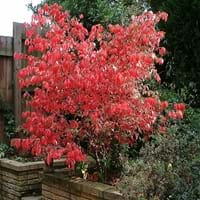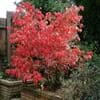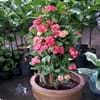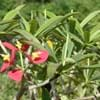Life Span
Perennial
Perennial
Origin
China, Japan, Korea
Hybrid origin
Types
Dwarf Burning Bush, Rudy Haag, Eastern Woo
Victoria Rhubarb
Colorado Red Rhubarb
Turkish Rhubarb
Number of Varieties
Not Available
Habitat
Dappled Shade, Hedge, Sunny Edge, Woodlands
gardens, Grassland, Humid climates, Tropical regions, Urban areas
USDA Hardiness Zone
4-9
5-8
Sunset Zone
A3, 2a, 2b, 3a, 3b, 4, 5, 6, 7, 8, 9, 10, 14, 15, 16
2b, 3a, 3b, 4, 5, 6, 7, 14, 15, 16, 17
Habit
Spreading
Clump-Forming
Flower Color
Yellow green
Light Pink
Flower Color Modifier
Not Available
Not Available
Fruit Color
Purple
Burgundy
Leaf Color in Spring
Green
Green, Dark Red
Leaf Color in Summer
Dark Green
Green, Dark Red
Leaf Color in Fall
Red
Green, Dark Red
Leaf Color in Winter
Not Available
Light Green
Leaf Shape
Pinnate
Compound
Plant Season
Spring, Summer, Fall
Spring, Summer, Fall
Sunlight
Full Sun, Partial Sun, Partial shade, Full Shade
Full Sun, Partial Sun
Type of Soil
Clay, Loam, Sand
Clay, Loam
The pH of Soil
Acidic, Neutral, Alkaline
Acidic, Neutral, Alkaline
Soil Drainage
Average
Average
Bloom Time
Late Spring
Summer, Late Summer
Tolerances
Not Available
Drought
Where to Plant?
Container, Ground, Pot
Ground
How to Plant?
Root Division, Seedlings, Semi-hardwood cuttings
Stem Planting
Plant Maintenance
Medium
Medium
Watering Requirements
Average Water Needs, Do Not over Water, Requires regular watering
Do Not over Water, Requires regular watering, Use Mulches to help prevent water loss during hot and windy weather, Water Deeply
In Summer
Lots of watering
Lots of watering
In Spring
Moderate
Moderate
In Winter
Average Water
Average Water
Soil pH
Acidic, Neutral, Alkaline
Acidic, Neutral, Alkaline
Soil Type
Clay, Loam, Sand
Clay, Loam
Soil Drainage Capacity
Average
Average
Sun Exposure
Full Sun, Partial Sun, Partial shade, Full Shade
Full Sun, Partial Sun
Pruning
Prune if you want to improve plant shape, Prune in early spring, Prune in late winter, Prune when plant is dormant, Remove branches, Remove damaged leaves, Remove dead branches, Remove dead leaves, Remove dead or diseased plant parts
Remove damaged leaves, Remove dead branches, Remove dead leaves
Fertilizers
12.5 pounds of a 16-4-8 formula fertilizers, All-Purpose Liquid Fertilizer
All-Purpose Liquid Fertilizer
Pests and Diseases
Red blotch
Red blotch
Plant Tolerance
Not Available
Drought
Flowers
Insignificant
Showy
Flower Petal Number
Single
Not Available
Foliage Texture
Medium
Coarse
Foliage Sheen
Matte
Glossy
Attracts
Birds
Not Available
Allergy
Poisonous, Toxic
Skin irritation
Aesthetic Uses
Showy Purposes
Showy Purposes
Beauty Benefits
Not Available
Not Available
Environmental Uses
Air purification, Bioremediation of some contaminated sites
Air purification
Medicinal Uses
Anodyne, Anthelmintic, Antiphlogistic, Antipruritic, Astringent, Blood tonic, Cancer, Carminative, Emmenagogue, Hypoglycaemic
Not Available
Part of Plant Used
Fruits, Leaves
Whole plant
Other Uses
Food for animals, Food for insects, Used As Food, Used as Ornamental plant, Used for its medicinal properties, Used for making hedge
Culinary use, Used as Ornamental plant
Used As Indoor Plant
No
No
Used As Outdoor Plant
Yes
Yes
Garden Design
Feature Plant, Hedges, Mixed Border, Screening, Wind Break
Feature Plant, Mixed Border
Botanical Name
EUONYMUS alatus
RHEUM 'Ace of Hearts'
Common Name
Winged euonymus, Burning bush, Winged burning bush, Winged wahoo, Winged spindle-tree
Ace of Hearts Ornamental Rhubarb, Ornamental Rhubarb
In Hindi
Burning Bush Plant
सजावटी प्रकार का फल
In German
Brennender Busch Pflanze
Ornamental Rhabarber
In French
Bush brûlant des plantes
rhubarbe ornementale
In Spanish
La quema de la planta de Bush
Ornamental de ruibarbo
In Greek
Burning Bush Φυτών
καλλωπιστικά Ραβέντι
In Portuguese
Bush ardente Planta
ornamental ruibarbo
In Polish
Płonącego krzewu roślin
ozdobne Rabarbar
In Latin
Planta flammae rubi
decentius Rhubarb
Phylum
Magnoliophyta
Tracheophyta
Class
Magnoliopsida
Not Available
Order
Celastrales
Caryophyllales
Family
Celastraceae
Polygonaceae
Clade
Angiosperms, Eudicots, Rosids
Angiosperms, Core eudicots, Eudicots
Tribe
Euonymeae
Not Available
Subfamily
Celastroideae
Not Available
Number of Species
Not Available
Season and Care of Burning Bush and Ornamental Rhubarb
Season and care of Burning Bush and Ornamental Rhubarb is important to know. While considering everything about Burning Bush and Ornamental Rhubarb Care, growing season is an essential factor. Burning Bush season is Spring, Summer and Fall and Ornamental Rhubarb season is Spring, Summer and Fall. The type of soil for Burning Bush is Clay, Loam, Sand and for Ornamental Rhubarb is Clay, Loam while the PH of soil for Burning Bush is Acidic, Neutral, Alkaline and for Ornamental Rhubarb is Acidic, Neutral, Alkaline.
Burning Bush and Ornamental Rhubarb Physical Information
Burning Bush and Ornamental Rhubarb physical information is very important for comparison. Burning Bush height is 243.84 cm and width 243.84 cm whereas Ornamental Rhubarb height is 71.10 cm and width 81.30 cm. The color specification of Burning Bush and Ornamental Rhubarb are as follows:
Burning Bush flower color: Yellow green
Burning Bush leaf color: Green
Ornamental Rhubarb flower color: Light Pink
- Ornamental Rhubarb leaf color: Green and Dark Red
Care of Burning Bush and Ornamental Rhubarb
Care of Burning Bush and Ornamental Rhubarb include pruning, fertilizers, watering etc. Burning Bush pruning is done Prune if you want to improve plant shape, Prune in early spring, Prune in late winter, Prune when plant is dormant, Remove branches, Remove damaged leaves, Remove dead branches, Remove dead leaves and Remove dead or diseased plant parts and Ornamental Rhubarb pruning is done Remove damaged leaves, Remove dead branches and Remove dead leaves. In summer Burning Bush needs Lots of watering and in winter, it needs Average Water. Whereas, in summer Ornamental Rhubarb needs Lots of watering and in winter, it needs Average Water.





